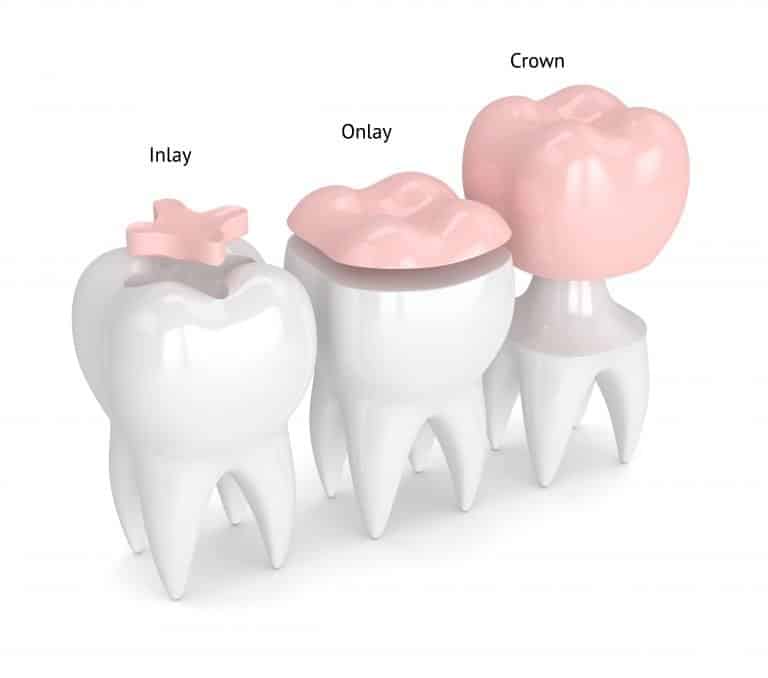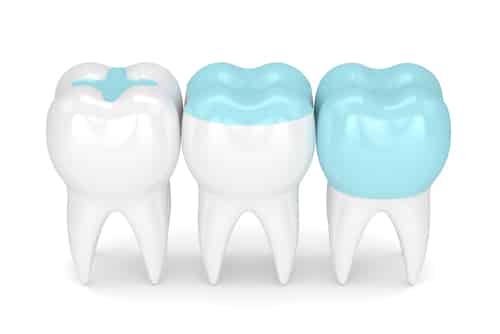Dental Crowns | Dental Onlays | Dental Inlays




Dental Inlays
A dental inlay is a type of dental restoration that is used to repair and restore damaged or decayed teeth. It is a custom-made filling that is made from a variety of materials, including gold, porcelain, or composite resin. An inlay is similar to a filling, but it is larger and is used to restore a larger area of the tooth. Unlike a filling, which is placed directly into the tooth, an inlay is made in a dental laboratory and is then cemented into the tooth by the dentist. Dental inlays can be used to repair teeth that have been damaged by decay, trauma, or wear and tear. They can also be used to improve the appearance of the teeth and restore their function. With proper care and maintenance, a dental inlay can last for many years.
Dental Onlays
A dental onlay is a type of dental restoration that is used to repair and restore damaged or decayed teeth. It is similar to a dental inlay, but it is larger and covers a larger area of the tooth. An onlay is custom-made in a dental laboratory and is then cemented into place by the dentist. Like an inlay, an onlay is made from a variety of materials, including gold, porcelain, or composite resin. Dental onlays can be used to repair teeth that have been damaged by decay, trauma, or wear and tear. They can also be used to improve the appearance of the teeth and restore their function. With proper care and maintenance, a dental onlay can last for many years.
Dental Crowns
A dental crown is a type of dental restoration that is used to cover and protect a damaged or decayed tooth. It is a tooth-shaped cap that is placed over the entire visible portion of the tooth, restoring its shape, size, strength, and appearance. Dental crowns are often used to restore teeth that have been severely damaged by decay, trauma, or wear and tear. They can also be used to support a dental bridge, cover a dental implant, or improve the appearance of misshapen or discolored teeth. There are several different types of dental crowns available, including porcelain, ceramic, metal, and resin. The type of crown that is best for each patient will depend on their specific situation and needs.
Tooth Inlays | Tooth Onlays
More conservative than a crown, Dental Inlays and Onlays are two treatment procedures for restoring natural tooth structure after decay or damage.
These are also known as indirect fillings unlike a conventional filling which is done in our office; these are custom fabricated to specifications in a selected external laboratory that has been vetted and has consistently delivered quality work for our patients.
These are then cemented or bonded to the surface of the tooth during a second visit to our clinic.
Unlike regular fillings, they do not weaken the tooth structure but instead, increase its strength.
If the tooth structure to be replaced by us is only within the cusp of the tooth, then we do an Inlay.
If the entire chewing surface including one or more cusps is to be covered by the new structure due to extensive damage to the area, then we do an Onlay, and the procedure is known as such.
Frequently Asked Questions | Dental Inlays & Onlays
Porcelain Inlays
Porcelain inlays are a type of dental restoration that is used to repair and restore damaged or decayed teeth. They are similar to dental fillings, but they are larger and are used to restore a larger area of the tooth. A porcelain inlay is custom-made in a dental laboratory and is then cemented into place by Dr Alps. Porcelain inlays are made from a strong and durable ceramic material that is resistant to staining and wear. They can be color-matched to the patient’s teeth, making them virtually invisible when they are in place. Porcelain inlays are an aesthetic and long-lasting option for restoring damaged teeth.
Porcelain Onlays
Porcelain onlays are a type of dental restoration that is used to repair and restore damaged or decayed teeth. They are similar to dental inlays, but they are larger and cover a larger area of the tooth. A porcelain onlay is custom-made in a dental laboratory and is then cemented into place by the dentist. Porcelain onlays are made from a strong and durable ceramic material that is resistant to staining and wear. They can be color-matched to the patient’s teeth, making them virtually invisible when they are in place. Porcelain onlays are an aesthetic and long-lasting option for restoring damaged teeth.
What are the Advantages of Inlays & Onlays?
- Appearance:
They have an attractive natural appearance, unlike silver/gold are much less prone to picking up stains and discolouring than white filling materials.
The porcelain can not only be shaped to mimic the original tooth but the patterns of the biting surface are naturally recreated with a little staining for added effect. - Strength:
They are not as destructive to the remaining tooth as crowns, and by preserving much of the natural tooth, they increase the durability of the tooth. - Wear:
The materials used to make the inlays/ onlays are incredibly durable and will not wear away like fillings, even under the stress of grinding. - Decay:
They are less prone to decay at the margins because of the custom fit and the excellent seal they achieve. - Durable:
They are more durable and last longer than fillings. - Hygiene:
As they are custom-made for individual teeth, they do not trap plaque in the same way that some fillings can and thus can be kept clean in the natural order of things. - Expansion:
They don’t expand and contract in the same way as filling materials thus reducing the stresses on the tooth.
What are the disadvantages of an Inlays & Onlays?
- Two Visits:
Unlike fillings, they require two visits to complete, unless you opt for using a CEREC or CAD-CAM system. - Cost:
They involve a laboratory stage, and as such, they are more expensive than the price of fillings but are cheaper than crowns. - Wear:
While they do not wear out themselves, some of the harder porcelain materials (such as zirconia) run the risk of wearing the opposing natural tooth – especially if the glaze is removed, when we adjust the bite. This isn’t a risk if the inlay/onlay bites on a filling or crown. - Failure: They can, of course, fail. This would be a bonding issue and while the cement used is super strong, occasionally they can come off; in which case most of the time, they can simply be re-bonded (provided you still have it!). It is, as with any restoration (crowns, veneers, fillings) also possible for the tooth to get decay at the margins if there is a problem with the fit or you are not doing your part and keeping it clean.
Why would I need an Inlay or an Onlay?
Inlays and onlays can be useful for restoration in some situations, the main ones are:
- To restore a large cavity and weakened the tooth
- Instead of a filling
- Instead of a crown
- To avoid a root canal, post and crown.
- To restore a large cavity that weakened the tooth
- Dental caries (tooth decay)
- Food Traps
- If a tooth has a very large amount of decay, then a crown or an inlay/onlay becomes a more dependable long-term solution, compared to just having a filling.
- Failed fillings : Sometimes you may have had a large filling that has failed or another piece of that tooth that breaks away. It may be possible to repair the tooth or to replace the filling, but it is likely that at some point this will fail again and you will have to proceed to an inlay/onlay, or a crown. Often it is more sensible and more economical to proceed sooner to one of these indirect long-term treatments.
- Cracked teeth
If part of a tooth fractures under massive biting forces (generally in people who have a grinding or clenching habit), inlays/onlays can be used to restore the part of the tooth that has broken.
How are Onlays done?
It takes two appointments for the onlays treatment to be completed.
- 1st visit:
At the first meeting, we will be numbing the area to be treated with a local anaesthetic to make the procedure most comfortable for you.
Any decay or damage is removed, so you have a sound foundation of tooth structure to support your future Onlay.
We use an intra-oral scanner to scan your tooth in 3-D to receive accurate measurements and eliminate the need to take moulds or impressions which can be unpleasant especially if you are a gagger.
This scan is sent off to the dental laboratory, where a dental onlay is created that will fit your tooth correctly.
Onlays are usually made of porcelain, which often most closely matches the colour of the tooth, but they can also be made from gold if you so desire.
While your Onlay is being created at the lab, we create a custom-made temporary restoration (cover or filling) for your tooth to protect it until your next appointment.
Allow yourself about 60minutes for this appointment. - 2nd Visit:
At the second appointment, we will remove the temporary restoration and then take time to ensure the Onlay fits correctly.
Only when the Onlay fits correctly, we will bond the Onlay to the tooth with a strong resin adhesive.
The Onlay treatment is completed with a polish to ensure a smooth and aesthetically pleasing finish.
Allow yourself about 45 minutes for this appointment.
We may schedule you for a review appointment to ensure that you feel most comfortable with your new filling initially, any new tooth surface may seem a little odd, but you soon get used to the new tooth surface and how it feels and looks in your mouth.
After Care for Inlays & Onlays
Caring for your Onlay is just as important as for your natural teeth.
Although the restorations are made from the highest quality materials, your natural teeth and surrounding gums can still develop plaque and tartar build-up which could lead to gum disease.
A thorough at-home oral care routine and attending active maintenance appointments will add to the long-term success of your dental Onlay procedure and keep your teeth and gums healthy.
Onlays vs. Metal Fillings
- Onlays are durable — Strength is one of the major advantages of Onlay. Depending on your aesthetic needs and budget, dental onlays can be made from gold, composite resin or porcelain and can last up to 10 years.
- Onlays help to strengthen teeth as they are bonded directly into the tooth, unlike traditional metal fillings which need cutting additional tooth structure for mechanical retention thereby actually reducing the strength of the teeth.
- Onlays prolong tooth life and prevent the need for more dental treatment in the future as there is a reduced chance of decay under the filling. A dental onlay extends over the cusps of the treated tooth.
Many patients are now choosing to have their amalgam fillings replaced with these tooth-coloured options. Inlays and onlays are the ideal solutions for replacing old fillings as they will strengthen your teeth and enhance the look of your smile.
Onlays vs. Crowns
Onlays and crowns cover the surfaces of teeth and help protect them from further decay, but onlays are more conservative treatments than crowns.
An onlay preparation only removes the decayed areas of the tooth to fit an onlay.
However, to fit a crown, we must also prepare some healthy tooth structure to offer a 360-degree full coverage up to your gum line or just above your gum line. The crown then fits over the remaining portion of the tooth offering full well-rounded protection to the tooth.
Just like crowns, Onlays can be made in Composite, Gold and Porcelain material.
What is the difference between inlays, onlays and other white fillings?
Though white fillings may be suitable for smaller cavities or decay, there may be some concerns with larger fillings as white fillings are bonded chair-side with composite resin material than fabricated in a dental laboratory.
When the composite fillings are cured or hardened with blue light, it shrinks a fair bit. As it shrinks, it pulls in on the tooth and may crack the remaining thin enamel which is brittle.
A porcelain Onlay is injection folded or computer cut to fit your tooth. There is virtually no shrinkage stress with this method and therefore no cracking of the tooth.
The materials used to make Inlays and Onlays are stronger than other white filling materials.
Another difference when comparing Inlays and Onlays to other fillings is the potential risks regarding food traps and gum disease.
As white fillings do not compact down the cavity like traditional amalgam fillings, a fine gap may be left behind between the teeth that catch food especially fibrous food which could be annoying and painful, to begin with, but later could result in decay under the filling with the potential risk of nerve damage.
Food traps can also lead to potential gum disease and bone loss and eventually abscess formation.
If the cavity extends below the gum line and there is a ledge or defect around the collar of the filling, it can be difficult to manage that area.
As Onlays and Inlays are fabricated in the laboratory, they fit the collars of your tooth quite precisely allowing you easy access for flossing and thereby avoiding the risk of decay under the filling or potential gum disease.
What is a Dental Crown?
A dental crown is a type of dental restoration that is used to cover and protect a damaged or decayed tooth. It is a tooth-shaped cap that is placed over the entire visible portion of the tooth, restoring its shape, size, strength, and appearance.
Dental crowns are often used to restore teeth that have been severely damaged by decay, trauma, or wear and tear. They can also be used to support a dental bridge, cover a dental implant, or improve the appearance of misshapen or discolored teeth.
There are several different types of dental crowns available, including porcelain, ceramic, metal, and resin. The type of crown that is best for each patient will depend on their specific situation and needs.
To place a dental crown, Dr Alps will first need to prepare the tooth by removing any damaged or decayed tissue. This will help to ensure that the crown fits properly and is comfortable for the patient.
Next, Dr Alps will take an impression of the prepared tooth and the surrounding teeth. This impression will be used to create a custom-made crown that is designed to fit the patient’s mouth perfectly.
While the crown is being made, Dr Alps will place a temporary crown on the prepared tooth to protect it. The temporary crown will be removed and replaced with the permanent crown at a follow-up appointment.
Once the permanent crown is in place, Dr Alps will make any necessary adjustments to ensure that it fits properly and is comfortable for the patient. The crown will be permanently cemented in place, and the patient can eat and drink normally.
Dental crowns are a safe and effective way to restore damaged or decayed teeth. They can help to improve the appearance of the teeth and restore their function. With proper care and maintenance, a dental crown can last for many years.
Frequently Asked Questions | Dental Crowns
What are the different types of Dental Crowns?
There are primarily three varieties, they are,
- Metal Crowns: These are known for their toughness and endurance, these restorations are made using gold or silver-coloured alloy.
- Ceramic Crowns: These restorations are made using “engineered” dental ceramic or porcelain. Some of these varieties are known for their enhanced looks while others exhibit high strength, however, finding both properties combined is often a challenge. They have evolved significantly over the decades with improved fabrication technology, material science and adhesive engineering to now offer a high-performing durable solution.
- Porcelain-fused-to-metal (“PFM”) – These are a hybrid construction wherein porcelain encasing covers a substructure made of metal. These provide both excellent aesthetics and durability.
When would I need a Dental Crown?
Dr Alpa Thakkar may advise Dental Crowns as a part of your treatment plan. Crowns are useful for some specific dental issues, such as:
- To Replace Large Filling:
When replacing a large filling is not feasible due to insufficient tooth structure to support a new dental filling. - To Restore damaged teeth:
Whether decay damaged your tooth, through injury or some other reason, crowns can restore your natural tooth’s functionality and help prevent further damage. - To Support weakened teeth:
Sometimes large fillings leave behind a small amount of natural tooth, but a crown can help protect and preserve what’s left of the tooth structure. - For Cosmetic Purposes:
If your tooth is discoloured or damaged, crowns can help you remedy that. Just be careful while you undergo teeth whitening – it won’t respond to bleach in the same way as a natural tooth, and you could risk an uneven colour. Dr Thakkar would mitigate such risks by taking a full examination of your dental and medical history. - Post Root canal treatment:
It’s common to need a crown after having done a root canal as the remaining tooth may sometimes be weaker and vulnerable to bacterial infection. Fitting a crown over your natural tooth can help protect it from further damage.
Dental implants: Crowns are used to attach to a dental implant and replace a missing tooth.
How Do Dental Crowns Work?
Think of crowns as helmets for your existing teeth.
Crowns are preferred when the damage to the tooth is extensive, and the tooth cannot be rectified with a Tooth Filling or with a Dental Inlay and Onlay Procedure.
They fit over the remaining part of an existing tooth structure just like a helmet would fit over a rider’s head, making the whole structure appear like a natural tooth while making it stronger and more durable.
Another terminology used for them is ‘Caps’, as in it caps the tooth and encapsulates it in a way.
Dental Crowns: Risks & Complications
A significant reduction in tooth structure may be required (50-75%) to increase the strength and retention which then raises the possibility of tissue and nerve damage while also further weakening the underlying tooth structure.
Conventionally, these are simple procedures and widely practised however Dr Alpa Thakkar incorporates a more modern approach whereby a much kinder treatment on the tooth is adopted.
In her view, patients should opt for dental crowns as caps only as a last resort.
In your consultation with Dr Alpa Thakkar, she will explain in greater detail the advantages and disadvantages of the various materials, and alternatives to the treatment and advise on the suitability of the procedure for your needs.
How long will a Dental Crown last?
The material of the crown is the key however if aided with good hygiene and a considered diet, you can expect your Crowns to last for over a decade or more.
Regular Brushing and flossing with a scheduled professional cleaning can help to prevent tooth decay, gum disease and plaque buildup, thus increasing the longevity of your crowns.
How much does Dental Inlays / Onlays / Crowns Cost?
Check out the rough estimate on our pricing page



